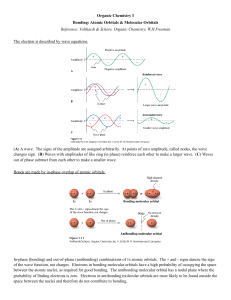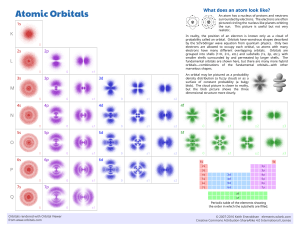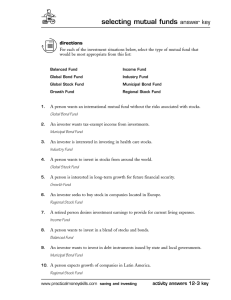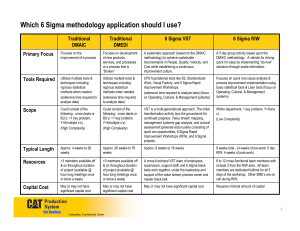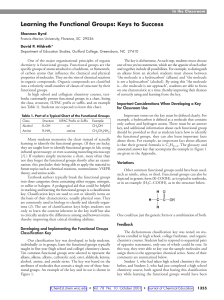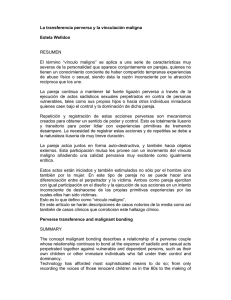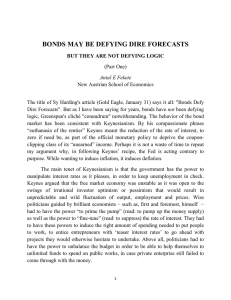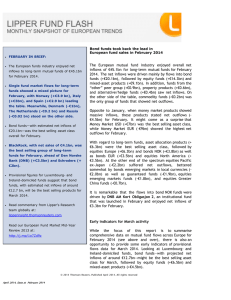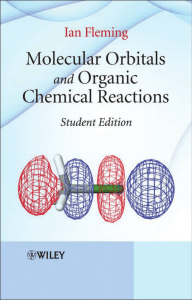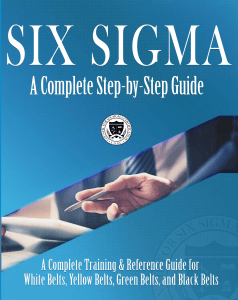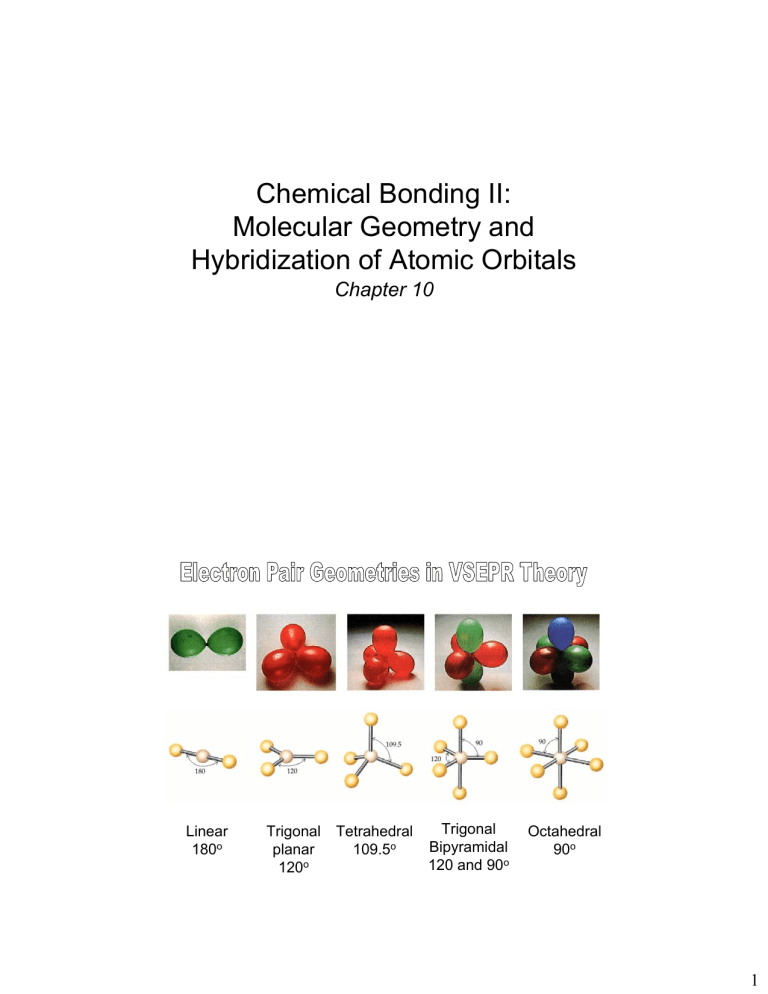
Chemical Bonding II: Molecular Geometry and Hybridization of Atomic Orbitals Chapter 10 Linear 180o Trigonal planar 120o Tetrahedral 109.5o Trigonal Bipyramidal 120 and 90o Octahedral 90o 1 linear Linear (AB2) Trigonal planar (AB3) Trigonal planar Bent (AB2E) 2 Tetrahedral (AB4) Pyramidal (AB3E) Tetrahedral Bent (AB2E2) Trigonal Bipyramidal (AB5) Unsymmetrical Tetrahedron (AB4E) Trigonal Bipyramidal T-shaped (AB3E2) Linear (AB2E3) 3 Octahedral (AB6) Octahedral Square pyramidal (AB5E) Square planar (AB4E2) Lone Pairs Distort Bond Angles lone-pair vs. bonding pair repulsion > > bonding-pair vs. bonding pair repulsion lone-pair vs. lone pair repulsion 4 1. Determine the Lewis structure 2. Determine the number of electron pairs (or clouds) around the CENTRAL ATOM – multiple bonds count as ONE CLOUD (see next slide). 3. Find out the appropriate VSEPR geometry for the specified number of electron pairs, both bonding and lone pairs. 4. Use the positions of atoms to establish the resulting molecular geometry. Multiple Bonds and Molecular Geometry Multiple bonds count as one - e.g. 4 bonding pairs around C, but trigonal planar instead of tetrahedral. 5 LINEAR - AB2 e.g. BeCl2 TRIGONAL PLANAR - BF3 (AB3) - SO2 (AB2E) 6 TETRAHEDRAL - CH4 (AB4) - NH3 (AB3E) - H2O (AB2E2) TRIGONAL BIPYRAMIDAL - PCl5 (AB5) SF4 (AB4E) ClF3 (AB3E2) I3- (AB2E3) 7 OCTAHEDRAL - SF6 (AB6) - BrF5 (AB5E) - XeF4 (AB4E2) Example 10.1 Use the VSEPR model to predict the geometry of the following molecules and ions: (a) AsH3, (b) OF2, (c) AlCl4-, (d) I3-, (e) C2H4 8 Molecular Geometries of Molecules with more than 1 Central Atom cysteine Dipole Moments and Polar Molecules electron poor region electron rich region H F δ+ δ− 9 10.2 CCl4 vs CHCl3 Cl Cl C Cl Cl H Cl C Cl Cl Which molecule is polar? You must look at the geometry to decide. 10 Cl2CO 11 NH3 H2O These types of molecules, where C = central atom and T = terminal atoms of the same type, are never polar. 12 Valence Bond Theory (hybrid orbitals) The Orbital Overlap Model of Bonding H-H H-F End to end overlap = sigma (σ) bond Predicted Bonding and VSEPR Geometry for CH4 109.5 o Lewis Structure Electron pairs around C 13 Problem: the available s and p-orbitals are at 90o angles, not at the predicted 109.5o! New orbitals are constructed from pre-existing s, p, and d-orbitals = hybrid orbitals 1. Hybridize the CENTRAL ATOM ONLY (others as needed) 2. Only use valence shell electrons 3. The number of hybrid orbitals formed = number of atomic orbitals used 14 For CH4, we need 4 hybrid orbitals, so 4 atomic orbitals are required as follows: (s + p + p + p) = sp3 Needed to form 4 sigma bonds Fig. 10.7 15 Fig. 10.8 16 (will be upgraded as we proceed) 1. Hybrid orbitals get 1 electron for a σ-bond, 2 electrons for a lone pair. sp3 hybridization for H2O Needed to form 2 sigma bonds and 2 lone pairs 17 BF3 - trigonal planar according to VSEPR Theory (incomplete octet exception) 18 For BF3, we need 3 hybrid orbitals, so 3 atomic orbitals are required as follows: (s + p + p) = sp2 Needed to form 3 sigma bonds BeCl2 - linear according to VSEPR Theory 19 For BeCl2, we need 2 hybrid orbitals, so 2 atomic orbitals are required as follows: (s + p) = sp Needed to form 2 sigma bonds Ex 10.4 Describe the hybridization state of phosphorus in PBr5 20 For PBr5, we need 5 hybrid orbitals, so 5 atomic orbitals are required as follows: (s + p + p + p + d) = sp3d Needed to form 5 sigma bonds e.g. SF6 21 For SF6, we need 6 hybrid orbitals, so 6 atomic orbitals are required as follows: (s + p + p + p + d + d) = sp3d2 Isolated S atom Needed to form 6 sigma bonds 22 Sigma (σ) bonds = end-to-end overlap 23 Pi (π) bond = side-by-side overlap C-C 1 σ bond C=C 1 σ bond 1 π bond C C 1 σ bond 2 π bonds 24 (upgraded – more will be added) 1. Hybrid orbitals get 1 electron for a σ-bond, 2 electrons for a lone pair. 2. Remaining electrons go into unhybridized orbitals = π bonds DOUBLE BONDS: Ethylene, CH2CH2 Lewis Structure: 25 Apply VSEPR Theory and Determine Hybridization H H C=C H H 26 sp2 hybridization on each C atom - sp2 hybrids and unhybridized p-orbital 27 σ bond = end-to-end overlap of the sp2 hybridized orbitals •• •• •• •• •• 1 electron from the sp2 hybrid on C, the other from the hydrogen 1s orbital π bond = side-by-side overlap of the unhybridized p-orbitals Electron from the unhybridized p-orbital on the C atom • • 28 Sigma (σ) Bonding in Ethylene Pi (π) Bonding in Ethylene 29 DOUBLE BONDS: Formaldehyde, CH2O Lewis Structure: Apply VSEPR Theory and Determine Hybridization H •• C=O H •• 30 sp2 120 o sp2 hybridization on C - 31 sp2 hybridization on O - Sigma (σ) Bonding in Formaldehyde •• •• •• •• •• 32 Pi (π) Bonding in Formaldehyde Electron from the unhybridized p-orbitals • • TRIPLE BONDS: Acetylene, C2H2 Lewis Structure: 33 Apply VSEPR Theory and Determine Hybridization H-C C-H sp hybridization on each C atom - 34 sp hybrids and unhybridized p-orbitals Sigma (σ) Bonding in Acetylene Unhybridized p-orbitals 35 Pi (π) Bonding in Acetylene Explain the Bonding Using Valence Bond Theory CO2 36 Sigma Bonding in CO2 Pi Bonding in CO2 37 VSEPR Theory - electron pair repulsions influence molecular shape Valence Bond Theory - atoms form bonds by overlapping atomic and/or hybrid orbitals Applied to O2 - 2(6) = 12 valence electrons or 6 pairs •• •• •• •• •• •• O = O• • O = O• • This prediction is WRONG! Since all of the electrons are paired up, the molecule should be diamagnetic, but experiments prove that it is PARAMAGNETIC! An additional refinement in bonding theory is necessary = 38 Molecular Orbitals - Preliminary Ideas Don’t forget that electrons behave like WAVES, and there are WAVE FUNCTIONS (ψ) that describe the electron position in space = ATOMIC ORBITALS (ψ2) e' Waves (electrons) can interfere with each other, either CONSTRUCTIVELY or DESTRUCTIVELY 39 Molecular Orbitals - destructive and constructive interference of atomic orbitals Sigma bond formation involving p-orbitals σ*2p σ2p 40 Pi bond formation involving p-orbitals π*2p π2p π*2p π2p Principles of Molecular Orbital Theory 1. The total number of molecular orbitals = total number of atomic orbitals contributed by the bonding atoms 2. Bonding MO’s are lower in energy (more stable) than antibonding MO’s 3. Electrons occupy molecular orbitals following the Pauli Exclusion Principle (spins pair up) and Hund’s Rule (remain unpaired as long as an empty orbital is available of the same energy) 41 Energy Levels of Molecular Orbitals for Homonuclear Diatomics - H2, O2, etc Molecular orbitals Atomic orbitals σ*2p π*2p σ2p π2p 2p 2s 2p Atomic orbitals 2s σ*2s 1s σ2s 1s σ*1s σ1s Molecular Orbital Electron Configurations e.g. O2 42 Bond Order Order = ½ [# electrons bonding MO’s # electrons antibonding MO’s] 1. The greater the bond order, the more stable the molecule 2. A high bond order means higher bond energies and shorter bond lengths. 3. Fractional bond orders are possible H2+ H2 σ*1s 1s σ*1s 1s 1s 1s σ1s σ1s Bond order = Bond order = 43 He2+ He2 σ*1s 1s σ*1s 1s 1s 1s σ1s σ1s Bond order = Bond order = Homonuclear Diatomic Molecules of Second Row Elements (the inner MO’s formed from overlap of the 1s orbitals aren’t shown) 44 Let’s take a look at the molecule ozone - O3 Lewis structure: 3(6) = 18 or 9 pairs sp2 hybridization of the central oxygen - 45 sp2 hybridization of the terminal oxygens - Sigma Bonding in O3 Explain using Valence Bond Theory 46 Pi Bonding in O3 Combine 3 p-orbitals = 3 molecular orbitals Pi Bonding in O3 • Antibonding π orbital • Nonbonding π orbital 47 Electrons in the bonding MO are free to move along the length of the molecule = delocalization •• Bonding π orbital Another example - NO3- -N|| O •• O •• - •• •• O •• •• •• - •• -N= | O •• O •• •• •• O •• •• •• - •• •• •• O •• •• •• =N| O •• •• O •• Hybridize all of the atoms to sp2 and combine the unused p-orbitals into molecular orbitals. 48 Benzene - C6H6 sp2 hybridize the C atoms and combine the unused porbitals into molecular orbitals. 49 50 51
